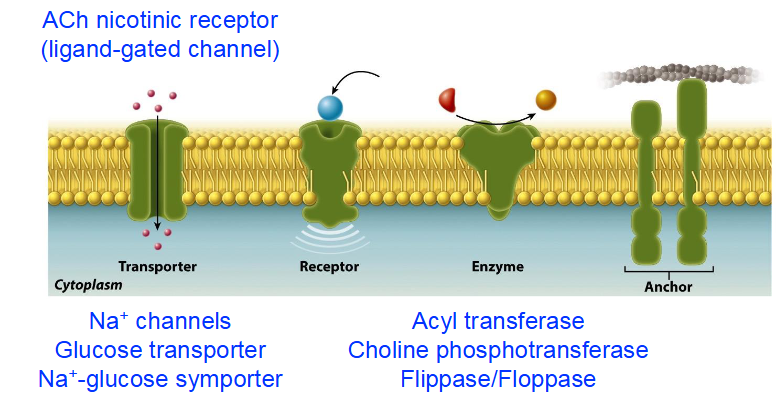🏳️⚧️ Transmembrane Proteins
1/23
There's no tags or description
Looks like no tags are added yet.
Name | Mastery | Learn | Test | Matching | Spaced |
|---|
No study sessions yet.
24 Terms
Phospholipid Organization
Phospholipids naturally arrange themselves into stable structures when placed into water (micelles/liposomes)

Transmembrane/Integral Proteins
e.g. Glycophorin A Dimer:
Transmembrane protein domain is hydrophobic peptide sequence (uncharged) that spans across PM
Sequence permanently attaches protein to PM
Structure typically in form of α helices
N and C terminals on opposite sides of the membrane
α Helix:
Most common protein structure element crossing biological membranes
Nine amino acids with hydrophobic side chains:
Glycine (Gly)
Alanine (Ala)
Valine (Val)
Leucine (Leu)
Isoleucine (Ile)
Proline (Pro)
Phenylalanine (Phe)
Methionine (Met)
Tryptophan (Trp)
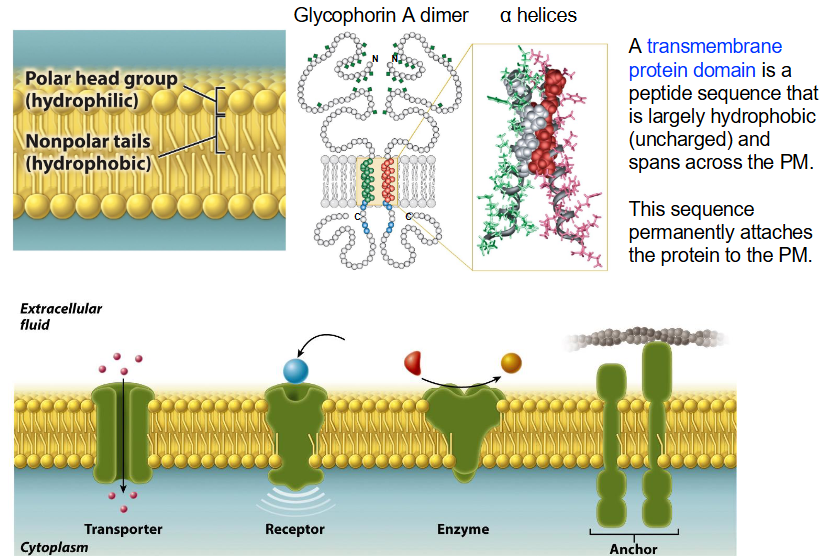
Tetraspanins (Transmembrane 4 Superfamily Proteins, TM4SFs)
Family of membrane proteins found in all multicellular eukaryotes
TM4SFs have four transmembrane α-helices and two extracellular domains:
One short (EC1)
One longer (EC2)
Some tetraspanins can be glycosylated (attachment of carbohydrate molecule) on the long extracellular loop
Play role in:
Cell adhesion
Motility
Proliferation
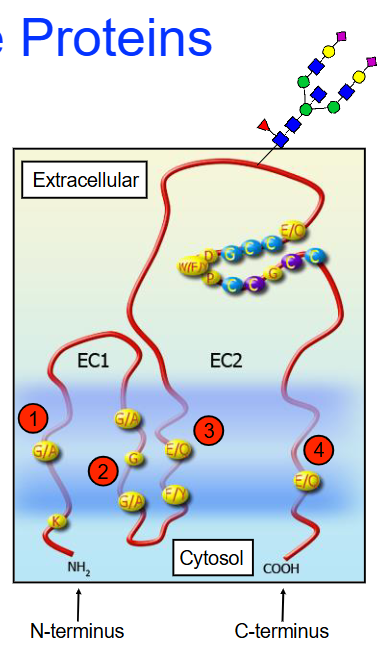
Movement of Substances Across Cell Membranes
Lipid bilayers do not allow many compounds or molecules to pass freely
Small uncharged molecules cross easily
O2, CO2, NO
Large, polar, or charged compounds cannot cross easily
Specific mechanisms required for controlled transport
Examples needing controlled transport:
K+
Na+
Ca2+
Glucose
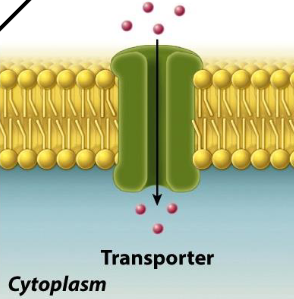
Mechanisms for Moving Molecules Across Membranes
Simple diffusion - Passive, nonmediated
High to low gradient
Small, uncharged molecules
Diffusion through a channel - Passive, nonmediated
Channel opens and closes
Small ions
Facilitated diffusion - Passive, transporter mediated
Transporter takes molecule, attaches something or causes conformational change, and transporter opens towards inside of cell to let new molecule through
Large molecules (e.g. glucose)
Active transport - Active, transporter mediated
Primary: Requires ATP to transport against gradient
Secondary: Uses an electrochemical gradient
Some mechanisms require energy
Active transport requires energy input
Diffusion-based processes do not require energy

Passive Mechanisms
Moves across cell membranes based on molecular concentrations
Does not require energy
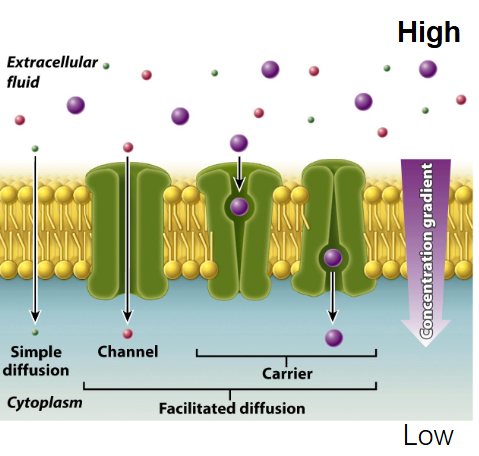
Simple Diffusion
Down a concentration gradient
Flow is downhill
Works only for very small uncharged molecules like O2 and CO2
Water is also uncharged due to covalent bonds
In covalent bonds, electrons are shared equally, so no net charge on atoms or molecule
Why water doesn’t easily pass through membranes:
Even though water is uncharged, it is polar
Lipid bilayer is hydrophobic, so polar molecules like water don't pass easily
Water needs special channels called aquaporins to cross the membrane efficiently

Channels
Channels
Protein channels used for passive transport
Effective for small charged molecules like Na+, K+, Ca2+, Cl-
Ions move down concentration gradients → downhill flow
Channels are selective → Allow only specific ions to pass through
Ion channels are made up of integral membrane proteins
Usually composed of multiple subunits that line an aqueous pore for ion movement
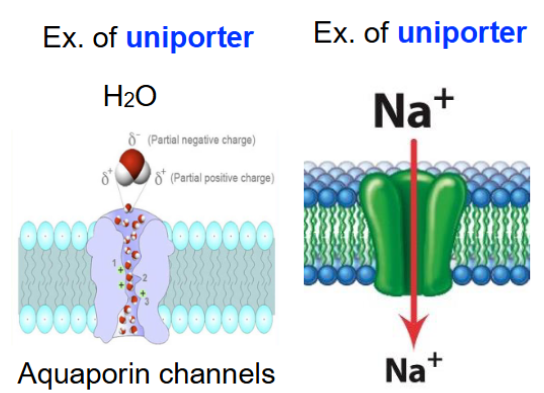
Ion Channels
Channels are often are gated → Can be open or closed
Gating allows response to different stimuli (e.g. neurotransmitters)
Channels can be turned ON or OFF in response to signals

2 Types of Gated Ion Channels
Voltage-gated
Ligand-gated
Voltage-Gated Ion Channels
e.g. Na+ and K+ channels
Respond to changes in charge across the membrane
Na⁺ concentration higher outside the cell, lower inside
Example: Neuron action potentials
Under non-depolarized conditions, neurons have low Na⁺ inside
Opening Na⁺ channels under these conditions leads to action potential and depolarization of membrane
Action Potential: Passage of electrical signal down nerve axon
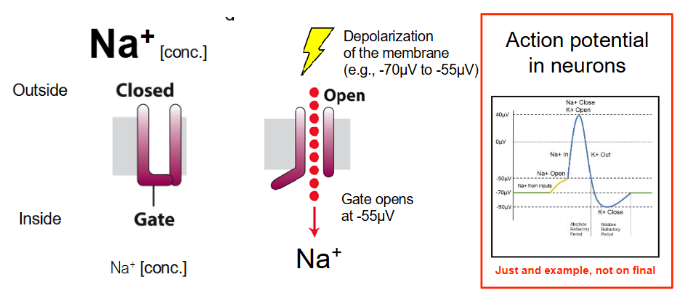
Ligand-Gated Channels
Channel responds to binding of specific molecule (ligand) on its surface
Ligand binding produces conformational change in receptor/channel structure
Only a ligand adapted to the binding site can produce an effect
e.g. Acetylcholine receptors
Ligand-gated ion channels
Acetylcholine binds to the receptor
Channel opens, allowing ions (Na⁺, Ca²⁺) to enter
Triggers muscle contraction or nerve signal transmission
Channel closes after acetylcholine detaches
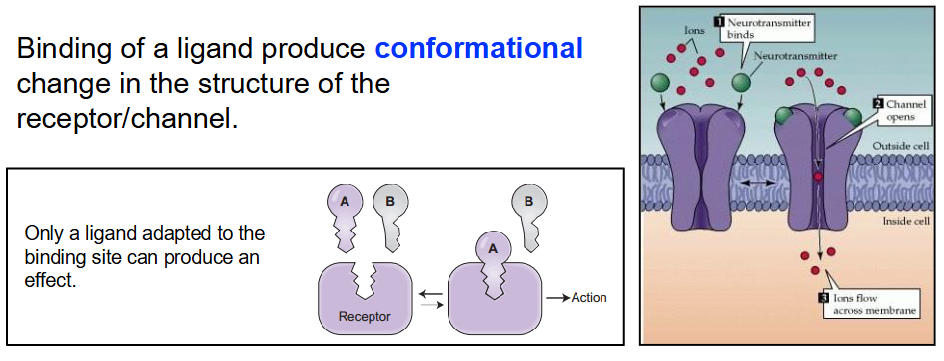
Toxins Targeting Ion Channels - Tetrodotoxin (TTX)
Tetrodotoxin (TTX): Potent neurotoxin
Found in pufferfish, blue-ringed octopuses, and moon snails
Effect of TTX:
Blocks Na⁺ channels
No sodium influx
No action potentials
No muscle contraction
Result:
Paralysis, including of diaphragm
Respiratory failure
Death
Toxins Targeting Ion Channels - Curare
Mixture of organic compounds from plants (e.g., Strychnos species) in Central/South America
Used as a paralyzing poison and hunting tool historically
Curare as a competitive antagonist:
Binds to the nicotinic acetylcholine receptor (nAChR)
Occupies the same site as acetylcholine (ACh)
Has equal or greater affinity than ACh
Does not produce a response
Example of a non-depolarizing muscle relaxant
Effects of Curare
Binds to nAChR (nicotinic acetylcholine receptor)
Blocks acetylcholine binding
No acetylcholine binding
No muscle contraction
Paralysis (muscle relaxation)
Used in medicine: Muscle relaxant during surgery

Carriers - Facilitated Diffusion
Facilitated diffusion:
Compound binds specifically to an integral membrane protein called a facilitative transporter
Change in transporter conformation allows compound to be released on the other side of the membrane
Compound moves down a concentration gradient
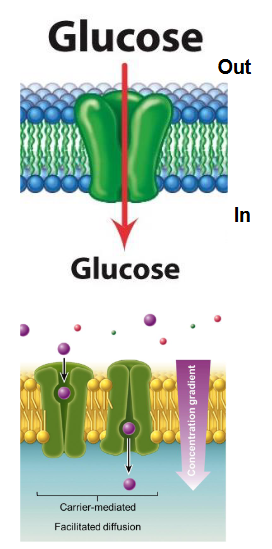
Carriers: Glucose Transporter - Facilitated Diffusion
Most animal cells import glucose from the blood into cells down a concentration gradient via facilitated diffusion
Transporter ready to accept glucose molecule
Glucose is accepted by transporter
Intracellular side of transporter opens
Glucose is released and cycle repeats
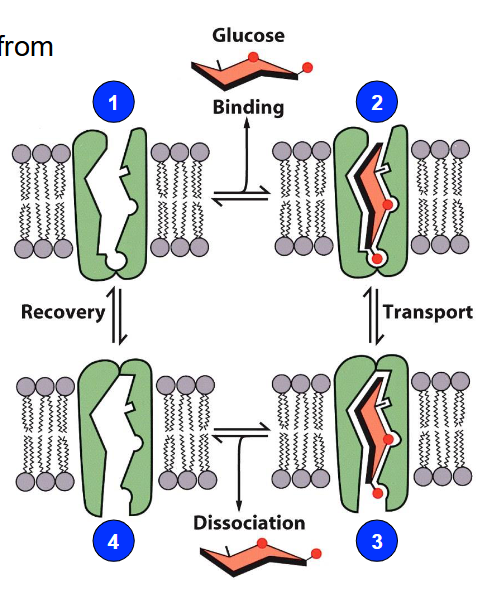
Another Type of Carrier: Symporter - Active Transport
Symporters and antiporters use active transport
Cells need to move substances from lower to higher concentrations in certain situations (e.g., glucose reabsorption in kidney cells after blood filtration)
Cells can't rely on a concentration gradient alone because equilibrium would stop glucose reabsorption
Solution: Use the chemical gradient of another molecule that doesn't reach equilibrium between extracellular and intracellular sides
The Na+ - Glucose Symporter - Active Transport
Simultaneous binding of 2 Na+ and 1 glucose to the outward-facing transporter
This binding causes a conformational change to the transporter (occluded conformation)
The transporter adopts an inward-facing conformation
The two Na+ molecules dissociate into the cytosol, pushing glucose into the cell
The transporter returns to the outward-facing conformation to repeat the cycle
Called active because glucose moves against its concentration gradient
No ATP is used directly in this process
Energy comes from Na⁺ gradient created by the Na⁺/K⁺ ATPase pump, which does use ATP
The transporter is a symporter since both Na⁺ and glucose move in the same direction (into the cell)

A Third Type of Carrier: Antiporter - Active Transport
Uses the concentration gradient of one molecule to move another molecule in the opposite direction
Example: Sodium-proton exchanger (Na+/H+ exchanger) in the kidney nephron
Transports Na+ into the cell and protons (H+) out of the cell
Maintains pH and sodium levels in specific kidney cells

Active Transport
Molecule binds to a protein in the membrane called an active transporter
ATP is used to change the shape of the transporter protein, allowing molecules to be moved across the membrane
This process moves molecules from low to high concentration (against the gradient)
Requires energy (ATP) to function
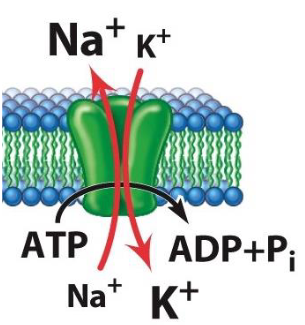
Na+/K+ Pump - Active Transport
Maintains the concentration of Na+ and K+ inside and outside the cell using ATP
For each ATP hydrolyzed:
3 Na+ ions are pumped out of the cell
2 K+ ions are pumped into the cell
Creates and maintains concentration gradients for Na+ and K+
Helps regulate cell volume and maintain resting membrane potential
Requires ATP to sustain Na+ chemical gradient
Supports activity of Na+-glucose symporter by maintaining Na+ gradient
Also helps return neuron to non-depolarized (quiet) state after action potential
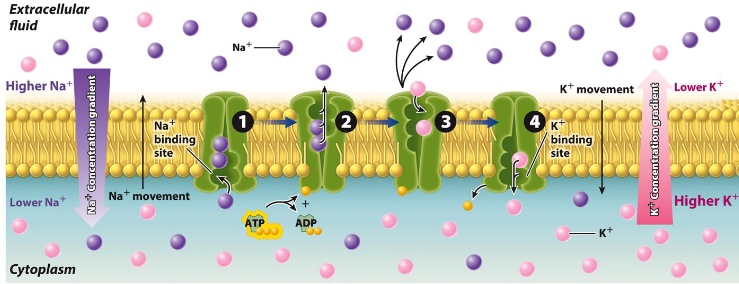
Maintaining Cell Size Through Active Transport
High intracellular Na+ concentration can affect cell volume
Active transport mechanisms like Na+/K+ pump help regulate ion balance
Red blood cell size changes with different solute concentrations (hypertonic, hypotonic, isotonic solutions)
Aquaporin channels allow water to move in/out of cells, helping maintain osmotic balance
Proper ion gradients prevent excessive swelling or shrinking of cells
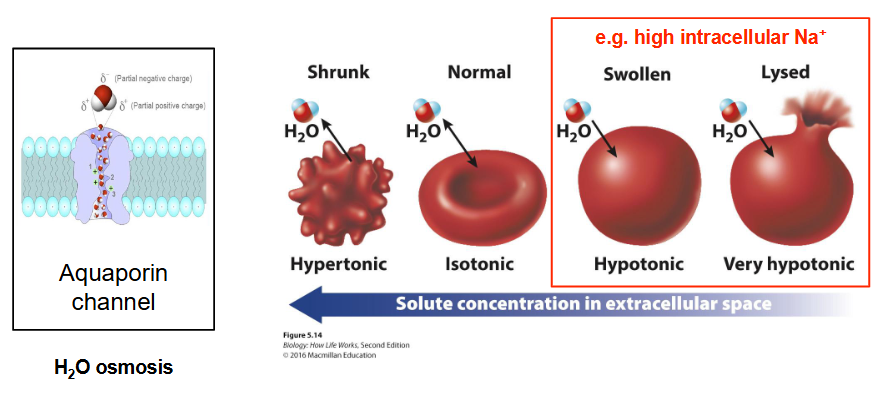
Summary
Integral membrane proteins have α helix regions made of hydrophobic amino acids that cross the membrane
Molecules cross membranes using passive (no energy) or active (uses energy) transport
Ion channels can open or close (gated)
– Some open when charge changes (voltage-gated)
– Some open when a specific molecule binds (ligand-gated)TTX blocks sodium ion channels → stops nerve signals → causes paralysis
Curare blocks acetylcholine receptors → stops muscle contraction → causes paralysis
Transmembrane Protein Summary
Transporters
ACh nicotinic receptor (ligand-gated channel)
Na+ channels (ion channel)
Glucose Transporter (facilitated diffusion)
Na+ -glucose symporter (secondary active transport)
Enzymes
Acyl transferase
Phosphatase
Choline phosphotransferase
Flippase
Floppase
